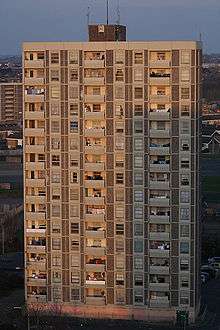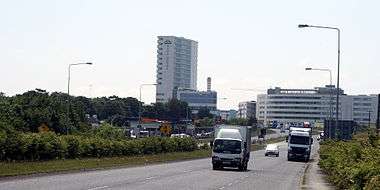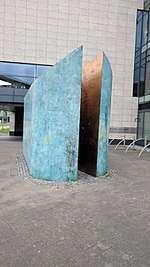Ballymun
Ballymun (Irish: Baile Munna) is an outer suburb of Dublin, Ireland, at the northern edge of the Northside, the development of which began in the 1960s to accommodate a housing crisis in inner city areas of Dublin. The area became well known for its high-rise tower blocks and flat complexes. It has several sub-districts such as Sillogue and Poppintree, and is in close proximity to Dublin Airport.
Ballymun Baile Munna | |
|---|---|
Suburb | |
 A view of the newly-renewed Ballymun village centre as of 2007 | |
| Nickname(s): The Mun | |
 Ballymun | |
| Coordinates: 53.39907°N 6.2817908°W | |
| Country | Ireland |
| Province | Leinster |
| Traditional county | County Dublin |
| Region | Dublin |
| Local authority | Dublin City Council |
| Founded by | Dublin City Council, formerly known as the Dublin Corporation |
| Elevation | 65 m (213 ft) |
| Population (2016)[1] | |
| • Total | 21,626 |
| Time zone | UTC0 (WEST) |
| • Summer (DST) | UTC+1 (WEST) |
| Eircode | DUBLIN D11 |
| Dialing Code | +353(0)1 |
| Geocode | O142401 |
| ISO 3166 code | IE-D |
| Vehicle registration | D |
| Website | dublincity |
In 1997, a regeneration plan was announced, which led to demolition of the flats and their replacement by new low-rise housing and some civic amenities, but also saw the loss of most of the area's shops. The regeneration had cost about one billion euro as of 2016.[2]
.jpg)
Geography
Ballymun lies on the plains of southern Fingal (the historic area, not the modern administrative council), sloping from northwest to southeast, from the catchment of the Santry River through that of the Wad River. The Santry rises in Harristown and Dubber, northwest of Ballymun, and crosses and drains the northern parts of the district. The Wad is the area's main watershed, with branches most notably around Poppintree; it flows southeast, eventually reaching the sea at Clontarf[3]
History
Ballymun was historically a rural area. The nearest village was Santry, dependent on the Domville family.
By the 1960s Dublin's housing stock was not only under pressure from a rising population but was also poorly maintained. House collapses in Bolton Street and Fenian Street in 1963 led to the death of four people, forcing Dublin Corporation to adopt ‘emergency measures’ to deal with the crisis.[4] In 1964, in a response to this housing crisis in inner city areas of the capital, plans were made to build high-rise flat complexes; construction started in 1966 and were completed by the following year. The seven 15-storey towers were named after Irish Republican revolutionaries, to commemorate the 50th anniversary of the 1916 Easter Rising. The flat complexes consisted of five 8-storey "districts" (Balbutcher, Balcurris, Coultry, Shangan and Sillogue) and three 4-storey "districts," two of which were part of Shangan and Sillogue, the third being located in Sandyhill. The Poppintree area of Ballymun was constructed in the late 1970s.
Some social problems occurred in the early years, as families which had grown up in dense city terraces close to Dublin's retail core, found themselves at the edge of the city, with few amenities beyond a travelling shop. Over time, Ballymun became notorious for a number of social problems, such as drug abuse and unemployment, and was impacted by negative media coverage of the area.
The current Ballymun district is not substantially in the townland historically called "Ballymun" — instead, it occupies several nearby townlands, the most significant of which is Stormanstown. Due to what were seen to be undesirable associations, some say that the area has shrunk since the completion of the tower blocks. For instance, in the early days of Dublin City University (DCU), then called NIHE, Dublin, this institution was sometimes referred to as being in Ballymun (part of the "Ballymun Project"), or sometimes in Whitehall, while today it is referred to and has a postal address in Glasnevin, even though it has not changed location. Indeed, much of the present day central Ballymun lies on lands once in the northern reaches of the Albert Agricultural College estate, the forerunner of the present-day DCU. Streets have also been renamed — for example, Ballymun Avenue (which was previously Collins Avenue Extension) was renamed Glasnevin Avenue after a local plebiscite in the 1970s.
Ballymun tower blocks

Among the opprobrium heaped on Ballymun, the deployment of the flats has been described by the environmental journalist Frank McDonald, in his book The Construction of Dublin, as the Irish state's 'worst planning disaster'. However, at the time of its construction, Ballymun was a sought-after location and prospective tenants had to pass an interview to get housing there. There were three types of apartment building: seven fifteen-storey towers, nineteen eight-storey blocks and ten four-storey blocks. The flats were built in the 1960s under the authority of Neil Blaney, the then Fianna Fáil Minister for Local Government.
According to geographer Joe Brady of University College Dublin, Dublin Corporation were sceptical about the Ballymun scheme:
They were made an offer by... Blaney which they couldn't refuse. He offered to build them 2,500 housing units at a time when their own housing development programme had to be ramped up and when you had the additional misfortune of the collapse of the tenement blocks in Fenian Street which meant that Dublin Corporation was bounced into dealing with all of its condemned houses at once... They would have taken anything from anybody at that point.[5]
The first tenants moved in between August 1966 and December 1966. By February 1969, when the National Building Agency's contract for Ballymun ceased and control of Ballymun was handed to Dublin Corporation, there was a total of 3,021 dwellings, all of which was publicly owned social housing.
Hotel Ballymun
In 2007, the by-then vacant Thomas Clarke Tower was temporarily transformed into a hotel as part of an art project.[6]
Regeneration of Ballymun

The creation of Ballymun Regeneration Limited as a limited company controlled by Dublin City Council initiated the beginning of the demolition of the Ballymun flats and the emergence of a "new town" of Ballymun. As of 2008, six of the seven towers (Pearse, Ceannt, Macdermott McDonagh, Connolly, and Clarke) as well as three eight-storey blocks and seven four-storey blocks have been demolished by DSM, with the residents generally rehoused in new "state of the art" housing in Ballymun. The new housing is a mixture of public, private, voluntary and co-operative housing. The residential aspects of the "new Ballymun" were largely completed by 2013. A documentary film entitled Ballymun Lullaby was released in February 2011 and includes scenes detailing the regeneration of Ballymun as well as its impact on the culture of its populace.[7]
The regeneration project, despite well-publicised questions about accountability and democratic participation, also delivered many other amenities, including reworked park areas, a major City Council office facility, Health Service facilities, a public leisure centre, the Axis arts centre, student accommodation, a new hotel, and some renewed retail facilities. A film of the leisure centre by filmmakers Joe Lawlor and Christine Molloy, LEISURE CENTRE, was made in 2007 and starred hundreds of Ballymun residents.[8] However, for a variety of reasons, the regeneration saw the departure of many shops, most notably the virtual emptying of Ballymun Shopping Centre, with the result that, as happened when Ballymun was first built up, the more than 17,000 residents have to travel to other districts for major grocery, and virtually all non-grocery, shopping.[2]
As part of the New Ballymun, a major tree-planting project called Amaptocare has been run, with more than 600 people sponsoring around 700 trees, and providing inscription texts which are engraved on plaques near the trees. Sponsors were informed that the all trees would be identified on a glass panel at Ballymun's central plaza; the plaza was completed by 2013, but the panel has, as of 2019, not yet been made.
2018 Metro Hotel Dublin fire
A multistorey hotel fire occurred in the building containing the Metro Hotel Dublin and two floors of apartments, on 21 March 2018. The fire broke out at approximately 8.00 pm and affected the top seven floors of the building. At least 12 units of Dublin Fire Brigade attended the building, and confirmed that the hotel was successfully evacuated.[9] Dublin Fire Brigade reported soon after the fire was extinguished that there were no reports of any casualties or people unaccounted for.[10] This included approximately 150 guests who were staying in the hotel.[11] The fire broke out in a private residence on the 13th floor above rooms for hotel guests.
The 15 storey hotel- and apartment-building was built as part of the Ballymun renewal, developed in 2006 by Pierce Contracting and a group of investors who included businessman Paddy Kelly.[12] The hotel was built as part of the Ballymun Renewal Scheme. The hotel was designed by Shay Cleary Architects for Pierse Contracting and was originally operated by the Days Inn Hotel group. It was scheduled to open on 9 June 2006.[13] In 2007 a charter plane with 118 passengers and crew narrowly avoided crashing into the hotel ater its pilot mistook the lights of the 16 storey building for the runway at Dublin Airport. The red lighting on the hotel's roof combined with its white internal light was mistaken for the approach lights of the airport's runway. The incident occurred at 11.34 pm on the night of 16 August 2007, when the McDonnell Douglas jet was carrying 112 passengers and six crew on a charter flight from Lisbon to Dublin.[14] In April 2014, the 88 bedroom Metro Hotel was put on the market in the region of €2.5 million. Along with the hotel, the sellers sought €3 million for 30 two-bed apartments on the upper floors of the property. In July 2016, planning permission was refused for the retention of masts and antenna on the hotel.[15]
Amenities
.jpg)

Ballymun Shopping Centre was the main source for shopping throughout much of Ballymun's first 40 years. However, due to regeneration, the centre has slowly emptied - in 2014 the anchor store, a Tesco supermarket, closed and was not replaced. As of 2017, the shopping centre still stands but only a handful of units remain occupied.
On the site of a former large underpass roundabout, a brand new civic complex was built, including The Axis, with the local health centre and Garda station also moved here, although their defunct buildings remain across the road. City Council offices are here, although the offices handling some services, such as driver licensing and motor taxation, closed.
Two hotels, Travelodge and Metro are located in this area, as well as a city-owned gym and leisure centre (the old Ballymun swimming pool was demolished in 2016 after being defunct for a number of years). A Bank of Ireland branch was demolished in 2017 and replaced by an AIB branch near the health centre.
A number of green spaces, parks and playgrounds have been built around the district.
The Republic of Ireland's only IKEA store is located fairly near.
There is a church in the old village centre.
There are a number of schools in each sub-district, including a Gaelscoil (Irish-speaking) primary school. Trinity Comprehensive is the only secondary school; this was formerly known as Ballymun Comprehensive.
Transport
Ballymun is served by a number of Dublin Bus routes to the city centre including the numbers 4,[16] 13 and the 155 [17] - [18] while the 17a[19] and 220[20] both heading towards Blanchardstown, the former coming from Kilbarrack.
The area was also envisaged to have an underground stop on the planned Metro North (Dublin city centre to Swords) line of the Dublin Metro. Plans for that have been revived with the Irish Governments Project 2040 and the revived MetroLink.
Journey time from Ballymun to the airport is estimated be around ten minutes by car, and to Dublin city centre around twenty-five minutes.
Ballymun in the media
For decades, Ballymun's reputation has been damaged by a high level of negative publicity in the media,[21] usually focusing on crime and drugs, whilst ignoring positive news.[22]
Television and film
The 1992 film Into the West was set and filmed in Ballymun.
Other fictional works that were set in the area were the 1994 drama mini-series Family and the 1982 short film One Day Time . Several documentaries of the area have been made throughout the years, most of which were during the demolition of the last block of flats.
Books
In September 2006, Gill & Macmillan published The Mun, by Lynn Connolly. This is a memoir covering the history of Ballymun from its inception to the final regeneration of the town. The Mun was Lynn's account of another side of Ballymun, of which she has fond memories. She wrote of a side of Ballymun not written of in the press stories about drug dealing and gangsters; a community that thrived in spite of the squalor. The Mun was Lynn's way of putting the story straight for the decent people of Ballymun.
In April 2009, Irish publisher Gill & Macmillan published Ballymun resident Rachael Keogh's account of her life as a heroin addict, Dying to Survive. Rachael started taking drugs aged 12 and for the next 15 years was hooked on a variety of substances. In 2006, after repeated attempts to get help, Rachael went to the media to publicise her plight.
In 2010 New Island Books published 'The Ballymun Trilogy' by the Dublin playwright, Dermot Bolger: three plays that chart forty years of life in Ballymun and which were all premiered in Axis in Ballymun before being staged in Britain, America, Poland and elsewhere.
Religion
Ballymun is a parish in the Fingal South West deanery of the Roman Catholic Archdiocese of Dublin.
Sport
There are a number of local sports groups, including:
- In soccer: St Pats Phoenix Football Club and Ballymun United Football Club.
- For the GAA, Ballymun Kickhams Gaelic Football Club and Setanta Hurling Club
Notable residents
- Barney Rock, Gaelic footballer
- Patrick Clarke, Filmmaker, Sillogue Rd from 1967-72.
- Glen Hansard, musician
- James McCarthy, Gaelic footballer
- Philly McMahon, Gaelic footballer
- Dean Rock, Gaelic Footballer
- MJ Hyland, author, lived there for two years. Uses the experience in "Carry Me Down".
- Aoife Dooley, writer, illustrator, comedienne lives there
References
- From Census 2016 - Includes totals from divisions/districts: Ballymun A, B, C, D, E & F
- Dublin, The Dublin Inquirer, 31 May 2016 "In Ballymun socks are scarce these days"
- Dublin, 2013: Doyle, Joseph W.; Ten Dozen Waters, 2013 (8th edition)
- "'I personally don't want to see another Ballymun again': the lessons of urban planning and regeneration". Holinshed revisited. 27 May 2016. Retrieved 20 November 2017.
- "Housing in Dublin" (podcast). The History Show. RTE. 25 October 2015. Retrieved 25 April 2017.
- https://www.irishtimes.com/news/art-project-s-guests-check-in-on-15th-floor-1.1293863?mode=sample&auth-failed=1&pw-origin=https%3A%2F%2Fwww.irishtimes.com%2Fnews%2Fart-project-s-guests-check-in-on-15th-floor-1.1293863
- "Documentary Ballymun Lullaby".
- http://civiclifetiongbahru.com/2011/04/01/civic-life-leisure-centre/ Archived 31 March 2012 at the Wayback Machine
- Brennan, Cianan (21 March 2018). "No reports of casualties as major fire rages at building complex in north Dublin city". The Journal. Retrieved 21 March 2018.
- @DubFireBrigade (21 March 2018). "#Ballymun UPDATE: It is important for us to give out correct and factual information. As of yet we have no reports of any casualties or people unaccounted for" (Tweet) – via Twitter.
- "'Serious fire' at hotel in Dublin". 21 March 2018. Retrieved 21 March 2018.
- "Metro Hotel Up for Sale". Hospitality Ireland. 8 April 2014. Retrieved 21 March 2018.
- North West Area Committee Meeting Progress Report (PDF) (Report). Ballymun Renewal Ltd. 16 June 2006. p. 10. Retrieved 21 March 2018.
- "Crash narrowly avoided after pilot mistook hotel for runway". The Examiner. Cork. 22 April 2009.
- "Residents at Santry Cross Vindicated on Masts – Reilly". Sinn Féin. 22 July 2016. Retrieved 21 March 2018.
- http://www.dublinbus.ie/en/Your-Journey1/Timetables/All-Timetables/4/
- http://www.dublinbus.ie/en/Your-Journey1/Timetables/All-Timetables/13/
- http://www.dublinbus.ie/en/Your-Journey1/Timetables/All-Timetables/13a/
- "Archived copy". Archived from the original on 11 July 2012. Retrieved 20 November 2017.CS1 maint: archived copy as title (link)
- "Archived copy". Archived from the original on 10 September 2011. Retrieved 20 November 2017.CS1 maint: archived copy as title (link)
- Example - Ballymun murder
- Example - Ballymun making transit camp
External links
| Wikimedia Commons has media related to Ballymun. |
- Ballymun Regeneration Ltd, with much about all aspects of the regeneration
- Photos of the demolition of one of the flats